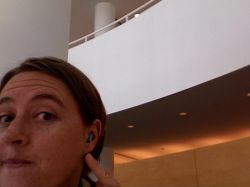Graduate Student, English Dept., UC Los Angeles
Kate Marshall is a Ph.D. student in English at UCLA. Her dissertation, “Corridor: Communication, Fiction, and the Organization of the American Interior,” looks at the traffic conditions of communication in twentieth-century American fiction through their spatial and informational transit systems. While her recent work is focused on architecture and media in pre-Cold War fiction, she has published on nanotechnology and risk theory, and has co-developed several interactive research projects on elements of narrative. Before beginning her graduate work, Marshall edited and wrote for technology and new media publications in San Francisco and London.
Links:
Built: An Installation on the Architectures of Narrative (with Matt Dubord) | Traversal: A Metaphor Project (with Joel Swanson)
Research Sample: From “Future Present: Nanotechnology and the Scene of Risk,” in Nanoculture: Implications of the New Technoscience (2004)
Charles, Prince of Wales, is worried about the future. He is an outspoken campaigner against developments in genetically modified food, high-rise building, and now nanotechnology. His Foundation for the Built Environment is attempting to preserve what he calls the “human scale” in built structures, before urban architecture progresses further upward. In a speech given to the Société de Géographie at la Sorbonne in February 2003, he used the rhetoric of his fight against genetic engineering to argue for architectural limitations: “After all, in this world of instant communications, jet aircraft and the video conference, why do people remain so attached to their village, their town, or their region? Why are so many people drawn to the more ‘organic’ character of traditional settlements than what might be termed the ‘genetically engineered’ and soulless developments of our contemporary world?” If the contemporary world, in this instance, has no soul, then the future looming just beyond it is the threatening force against which the prince is trying to set up his defenses. He opposes technological development to an older sense of space and environment, and in doing so calls upon his work to limit the biological engineering of “traditional” foodstuffs. So when, in April 2003, he was reported to have asked the Royal Society to examine the “enormous social and environmental risks” of nanotechnology, the combination of scale and science as his concerns cohered with his previous public agenda. By highlighting the potential size of nanotechnology’s scope and scale as ubiquitous and global, Prince Charles turns the science of the small into the technology of a vast and runaway future. And rather than promoting a purely reactionary stance, his public statements on genetic engineering, lived space, and nanotechnology are forward-moving, more anticipatory than backlash. He is reacting to the potential future of development over its current achievement. As biological science, space, and technology come together in the figure of incipient sovereignty, the shadow of their uncharted futures reaches back in the form of risk consciousness.
Contributions to Transliteracies Project:
Typotopo
Moving Canvas
El Muro

